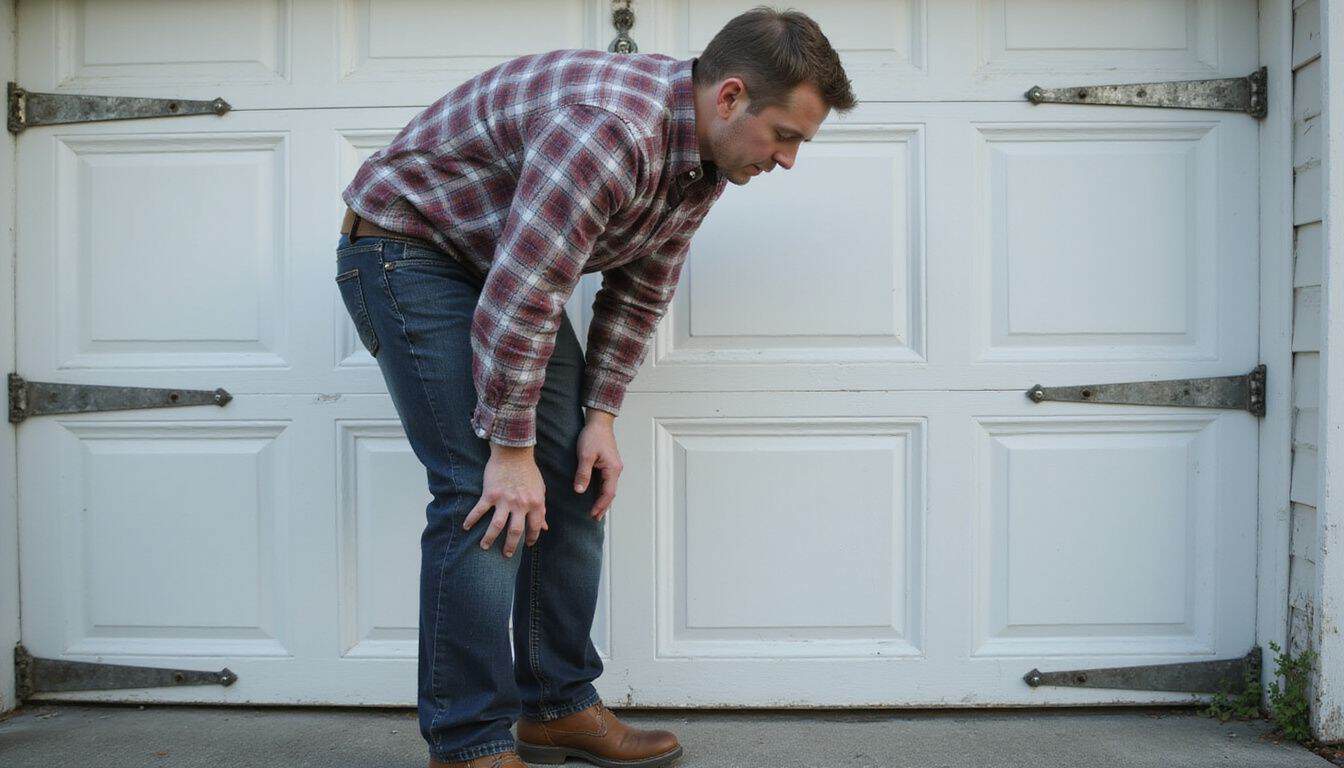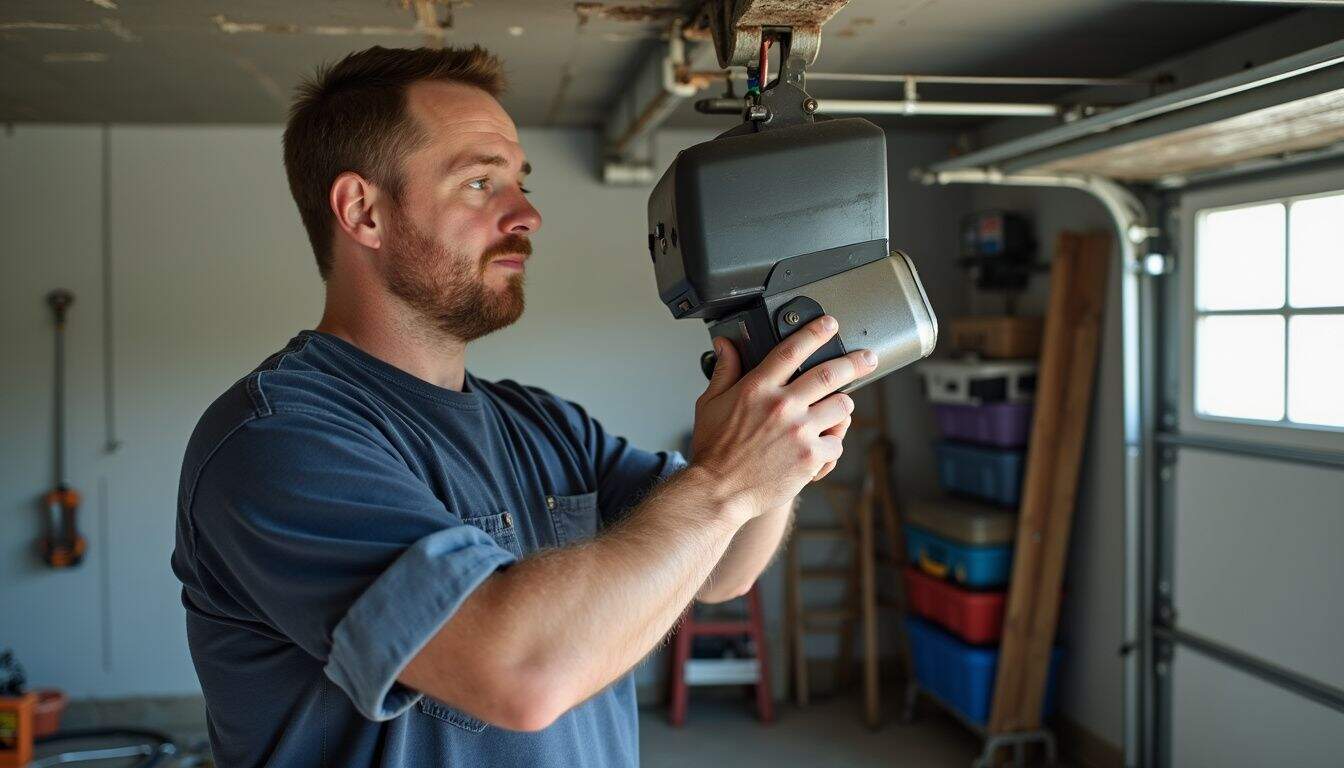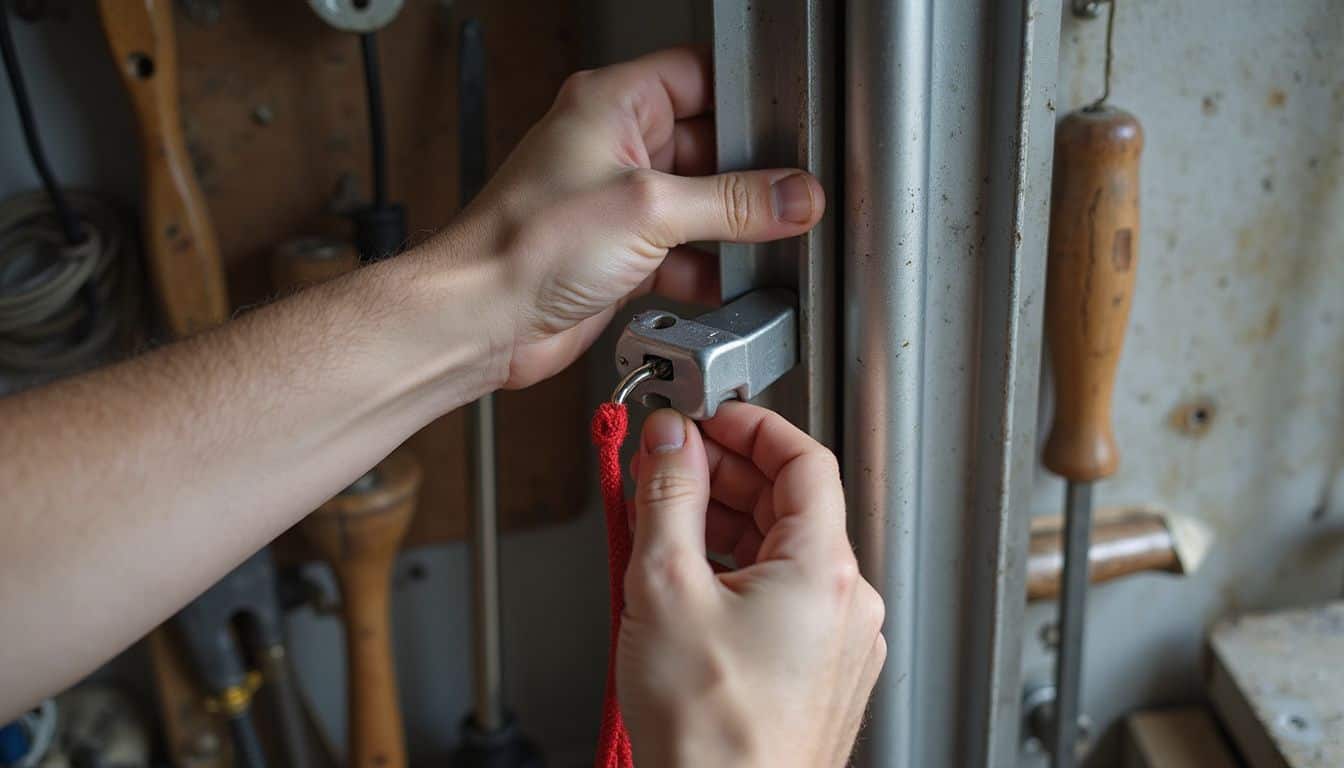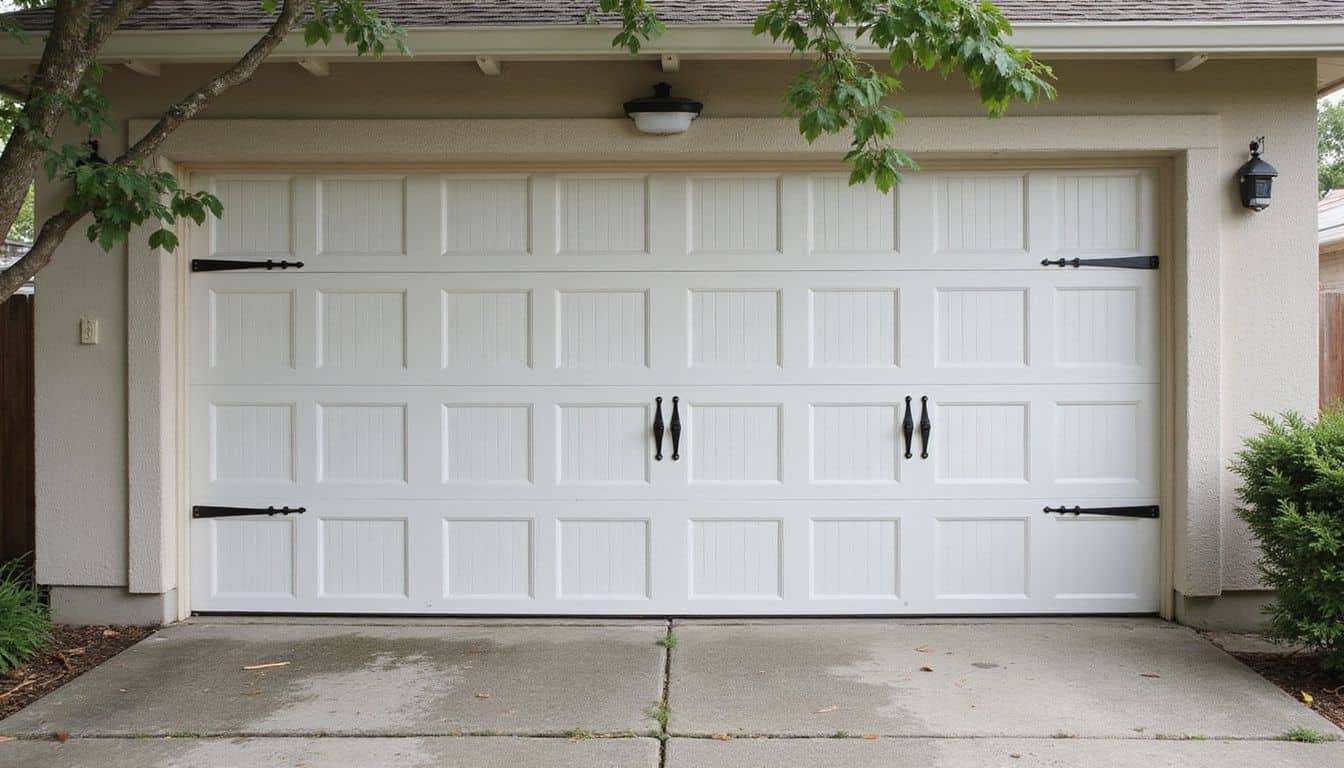Your garage door opener stops working during a power outage, and you’re stuck inside or outside your home. Most garage door systems include an emergency release cord that lets you operate the door manually when the power goes out.
This guide will show you exactly how to manually open a garage door safely, plus reconnect everything once the power returns. You’ll master this essential skill in just five simple steps.
Key Takeaways
Pull the red emergency release cord down firmly to disconnect your garage door from the automatic opener system.
Garage doors weigh 150-400 pounds, so use proper lifting technique with bent knees and get help if needed.
Clamp the door to both track rails after lifting to prevent accidental movement while working underneath it.
Reset the emergency release by pulling the cord opposite direction or using your remote to reconnect automatically.
Battery backup systems and improved manual release handles will become mandatory safety features by 2025.
Table of Contents
Steps to Manually Open a Garage Door

When your garage door opener fails, you need to know how to open it by hand. These five steps will help you get your door open safely, even when the power goes out or your motor breaks down.
How do I check if the garage door is fully closed?

First, look at the bottom of your garage door to check if it sits flush against the ground. Any gaps between the door and the floor mean the door hasn’t closed completely. Check the sides of the door too, making sure they align properly with the garage frame.
Listen for the sound of the door hitting the ground, this tells you the door has reached its lowest point.
Next, walk around your garage door to spot any obstructions that might block proper closure. Look for tools, debris, or items that could prevent the door from sealing completely. Check the door’s behavior with your automatic opener to see if it closes all the way down.
Some garage door openers have built-in safety features that stop the door if something blocks its path. If you notice problems with cables or hardware during your inspection, consider getting professional garage door cable repair to fix any issues.
Proper insulation around the door frame also helps you spot closure problems, as gaps will be more visible against the sealed edges.
A properly closed garage door should sit completely flush with the ground and frame, with no visible gaps or obstructions preventing a tight seal.
How do I use the emergency release cord to unlock the door?

The red emergency release cord hangs from your garage door opener’s trolley system. Pull this cord straight down with a firm, quick motion. You’ll hear a distinct click sound that tells you the trolley has separated from the opener carriage.
This click means the door is now free from the automatic system.
After pulling the cord, your garage door should slide smoothly along its track without any resistance. The trolley moves independently from the opener mechanism once you’ve disengaged it.
I’ve found that some older doors might need a gentle push to start moving after you pull the cord. Check that the door moves freely before attempting to lift it. Some homeowners add garage door murals to make this process more visually appealing, but focus on the mechanical keyhole connection between the trolley and opener first.
How do I safely lift and hold the garage door open?

Use the handle at the bottom to lift the door, keeping your back straight and bending your knees. Grip the handle firmly with both hands and pull upward in a smooth, steady motion.
Avoid using excessive force if you feel resistance, as this could damage the door or springs. I’ve found that most garage doors will lift easily once you release the opener mechanism properly.
Secure the door by clamping it to the track to prevent accidental opening or closing. Position the clamps on both sides of the door where it meets the track rails. This safety step keeps the door stable while you work underneath or move items in and out of your garage.
Make sure the clamps are tight enough to hold the door’s weight but not so tight that they damage the track material.
Reconnecting the Garage Door Opener

Once you’ve opened your garage door manually, you’ll need to reconnect the opener system to restore automatic operation. This process involves resetting the emergency release mechanism and reattaching the trolley to the motor unit, which brings your door back to normal function.
How do I reset the emergency release cord after manual use?

Resetting the emergency release cord takes just a few seconds. Pull the cord in the opposite direction to re-engage the opener mechanism. This simple action locks the trolley back into position with the automatic system.
You’ll hear a distinct click sound that confirms the trolley is properly secured. This click tells you the connection is complete and your garage door opener is ready to work automatically again.
Make sure the garage door stays fully closed during this process, as the opener won’t function correctly if the door sits partially open.
A properly reset emergency release cord ensures your garage door opener functions safely and reliably for years to come.
How do I reconnect the trolley to the opener mechanism?

Reconnecting the trolley to the opener mechanism requires the trolley to be locked back into place on the opener rail. Pull the red emergency release cord, guide it back to the opener, and slide the trolley until it clicks into position.
This clicking sound confirms the trolley has properly engaged with the opener mechanism.
Automatic reengagement offers an easier option for most guys. Activate the opener using your remote or wall button, then listen for the clicking sound that signals successful connection.
The opener will pull the trolley back into place without manual effort, making this method both simple and effective for getting your garage door system back to normal operation.
What safety precautions should I take when operating the door manually?

Safety comes first before you touch any part of your garage door system. Unplug the garage door opener from its power source before you start working. This prevents the motor from accidentally starting while you handle the door.
Keep the emergency release locked unless you plan to use it right away. Check that the door sits fully closed before you begin the manual process. A partially open door can slam down and cause serious injury.
Make sure no one stands under the door while you work. Clear the area of kids, pets, and any tools or equipment.
Physical strain poses real risks during manual operation. Garage doors weigh between 150 to 400 pounds depending on their size and material. Get help from another person if the door feels too heavy to lift alone.
Bend your knees and keep your back straight when lifting. Use your leg muscles instead of your back to avoid injury. Grip the door firmly with both hands on the bottom panel. Never try to catch a falling door with your hands or body.
Close the garage door promptly after manual operation to prevent security issues and weather damage. Test the door’s balance by lifting it halfway and letting go; it should stay in place if properly balanced.
What Changes Will Manual Garage Door Operations See in 2025?

Manual garage door operations will see significant safety improvements in 2025. Battery backup systems will become mandatory for new installations, ensuring your door works during power outages.
These systems will keep your garage man cave accessible even when the electricity goes out. Auto-reverse mechanisms will remain the most important safety feature, detecting objects and stopping the door before accidents happen.
New regulations will require upgraded manual release handles that disconnect more easily from the opener mechanism. Regular maintenance schedules will become standard practice, with professionals recommending annual inspections of all safety components.
Smart sensors will work alongside traditional manual systems, providing backup options when automatic features fail. These changes will make manual operation safer and more reliable than ever before.
People Also Ask
How do you manually open a garage door safely?
First, disconnect the opener by pulling the emergency release cord. Then lift the door slowly using both hands, keeping your back straight and bending your knees. Always check that the door stays open on its own before letting go.
What should you do before attempting to open a garage door manually?
Make sure the power is off to prevent the automatic opener from engaging unexpectedly. Check that no one is standing near the door, and ensure you have a clear path to lift it safely.
How do you reconnect the garage door opener after manual operation?
Pull the emergency release cord toward the motor unit until you hear it click back into place. Test the automatic opener with your remote to make sure it works properly again.
Can you manually open any type of garage door?
Most residential garage doors can be opened manually, but heavy doors or those with broken springs require extra caution. If the door feels too heavy or won’t stay open, call a professional instead of forcing it.
References
https://www.geisdoors.com/blog/garage-door-manually-open-close-guide/
https://agdiowa.com/blog/how-to-release-reset-your-garage-doors-emergency-cord/
https://www.garagedoorspokane.com/how-to-reset-garage-door (2016-01-20)
https://centralohiogaragedoor.com/blog/how-to-close-your-garage-door-manually/
https://www.garagedoorrepair.com/blog/reset-a-garage-door-after-opening-manually/
https://www.meadowsgaragedoors.com/blog/how-to-reengage-garage-door/
https://dbargaragedoors.com/blog/4-safety-tips-when-operating-your-garage-door-manually/
https://elitegaragelynnwood.us/blog/garage-door-safety-features-shouldnt-ignore-2025/ (2025-04-22)

